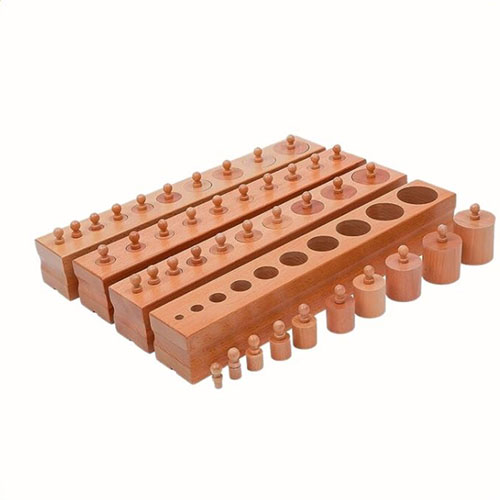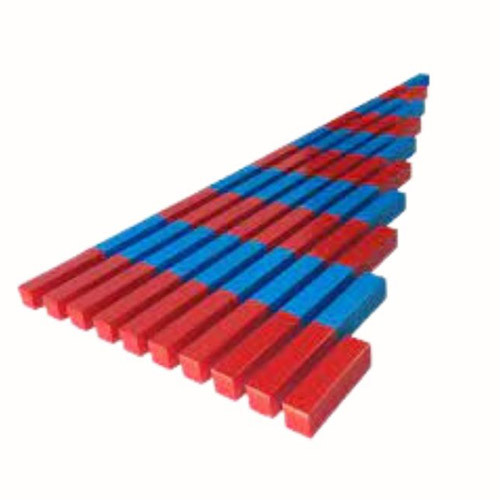Montessori materials play a crucial role in the Montessori education method, which was developed by Dr. Maria Montessori. This educational approach is designed to foster the holistic development of young learners, typically aged 2 to 6 years. Montessori materials are artistically crafted wooden toys/gadgets to align with the principles of Montessori education and offer numerous benefits for young learners. There is a huge list of Montessori material items for a Montessori classroom.
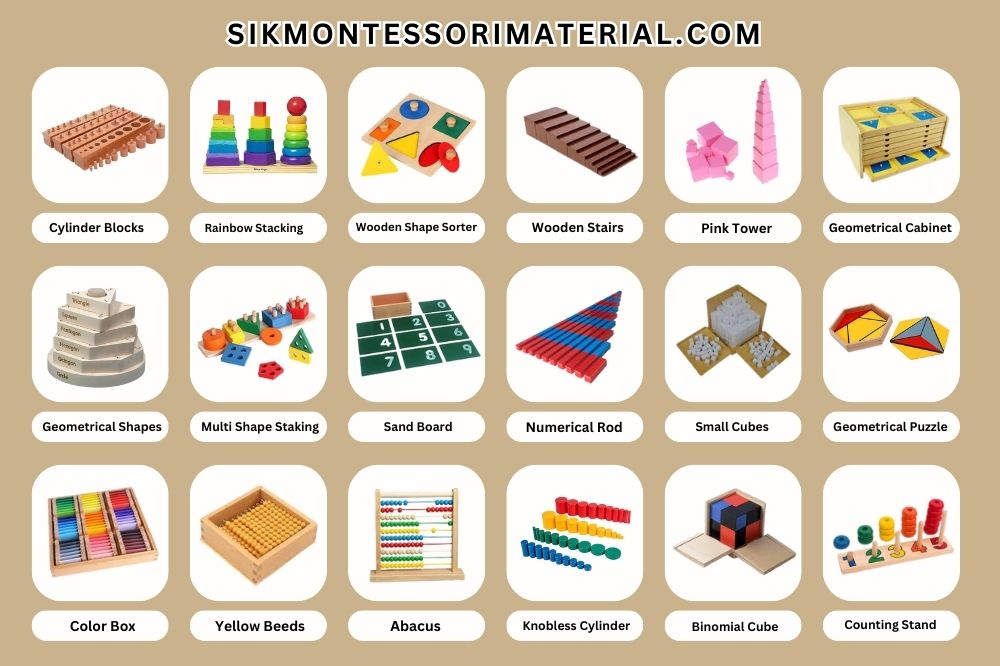
Commonly Used Montessori Items with Images:
cylinder blocks, rainbow stacking, wooden shapes sorter, brown wooden stairs, pink tower, geometrical cabinet, geometrical shapes, multi-shape stacking, sand board, numerical rods / red rods, small cubes, color box or color tablets, yellow beads, abacus, knob-less colored cylinder, binomial cube, and counting stand.
Knobbed Cylinder Blocks: Enhancing Fine Motor Skills
Knobbed Cylinder blocks, consisting of ten wooden cylinders varying in dimensions, provide a tactile experience for children. These cylinders can be removed from a container block using a knobbed handle, promoting the development of the three-finger grip essential for writing. Through activities involving removal and replacement, children refine their fine motor skills and spatial understanding.
Pink Tower: Understanding Dimension and Order
The pink tower, a set of ten pink cubes varying in size, empowers children to comprehend concepts of “big” and “small.” Through stacking the cubes in ascending order, youngsters grasp spatial relationships and practice precise manipulation. The inherent visual control of error encourages self-correction.
Brown Wooden Stairs: Grasping Concept of Size
The brown stairs, also known as the broad stair, invite exploration of thickness variations. Comprising ten sets of prisms with distinct thicknesses, this material aids in teaching concepts of “thick” and “thin.” Its interaction with the pink tower allows children to experiment with design possibilities, enhancing their creativity.
Knob-Less Colored Cylinders: Exploring Dimension and Pattern
The knobless colored cylinders, akin to the cylinder blocks, engage children in exercises involving dimension, stacking, and pattern creation. By manipulating these cylinders, children refine their motor skills and spatial perception.
Numerical Rods / Red Rods: Embracing Length and Quantity
The numerical rods, each differing in length, provide an experiential understanding of long and short. By manipulating these rods, children grasp concepts of measurement and quantity, setting the stage for mathematical comprehension.
Rainbow Stacking
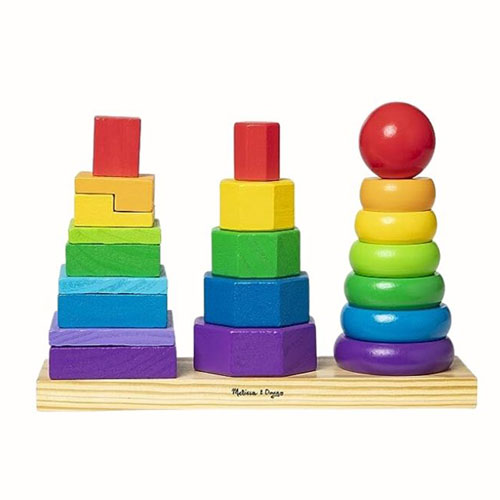
Rainbow Stacking: Stimulating Visual Perception
A classic stacking toy, the rainbow stacking set, offers vibrant wooden rings to stack on a rocking base. This engaging activity promotes color recognition, size differentiation, and hand-eye coordination. By experimenting with balance and order, toddlers develop crucial cognitive skills while enjoying screen-free play.
Shape Sorter
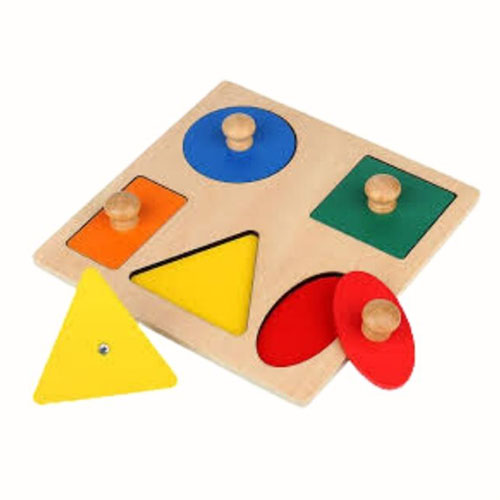
Wooden Shape Sorter: Exploring Geometry Playfully
Introducing geometric shapes to young minds, the wooden shapes sorter provides a simple yet effective tool for shape identification and fine motor skill development. With minimalistic design and focus on shape recognition, this material supports early cognitive growth.
Geometrical Cabinet

Geometrical Cabinet: Nurturing Shape Recognition
A cabinet housing various wooden shapes, the geometrical cabinet facilitates shape discrimination and identification. Through tactile exploration and play, children learn the names of shapes while enhancing their cognitive abilities.
Geometrical Shapes

Geometrical Shapes: Exploring Form and Symmetry
Geometrical shapes, including triangles, squares, pentagon, hexagon, octagon, and circles, form the foundation of spatial understanding. By arranging these shapes size-wise and exploring their symmetry, children develop critical thinking and pattern recognition skills.
Multi-shape Stacking
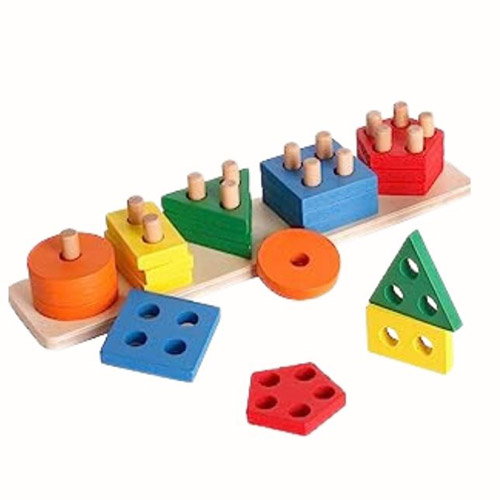
Multi-shape Stacking: A Multifaceted Learning Journey
With a diverse array of blocks, the multi-shape stacking toy offers numerous play possibilities. From recognizing numbers and colors to building patterns and objects, this material fosters fine motor skills, spatial concepts, and logical thinking.
Sand Board

Sand Board: Sensory Introduction to Letters
Montessori Sandpaper Letters serve as a tactile tool to introduce letters and letter sounds. Through sensory engagement, children build a strong foundation for literacy while enjoying hands-on exploration.
Small Cubes
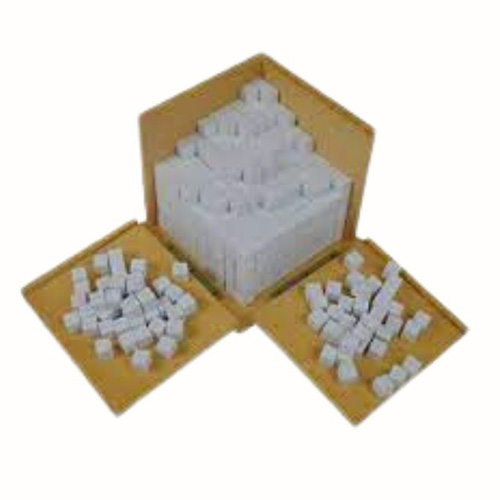
Small Cubes for Volume: Hands-On Mathematics
Small cubes for volume offer a tangible way to explore mathematical concepts. With one-thousand wooden cubes, children engage in activities that cultivate numerical understanding and spatial perception.
Constructive Triangles

Constructive Triangles: Creating with Geometry
The constructive triangles material empowers children to construct various geometric shapes using triangles. This hands-on experience sparks creativity and nurtures an appreciation for mathematical principles.
Color Tablets
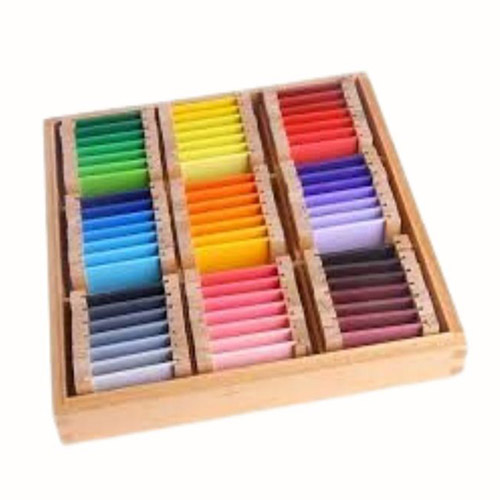
Color Box or Color Tablets: Exploring Color Perception
Developed by Maria Montessori, the Color Tablets facilitate color discrimination and understanding of primary and secondary colors. Through playful exploration, children broaden their color vocabulary and sensory awareness.
Yellow Beads
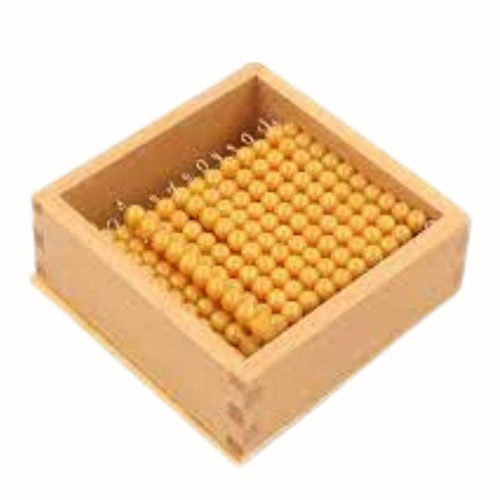
Yellow Beads: Unveiling Mathematical Concepts
Montessori Golden Beads, represented by yellow beads, bars, and cubes, provide a concrete introduction to arithmetic operations and place value. By manipulating these beads, children develop a profound grasp of mathematical concepts.
Abacus
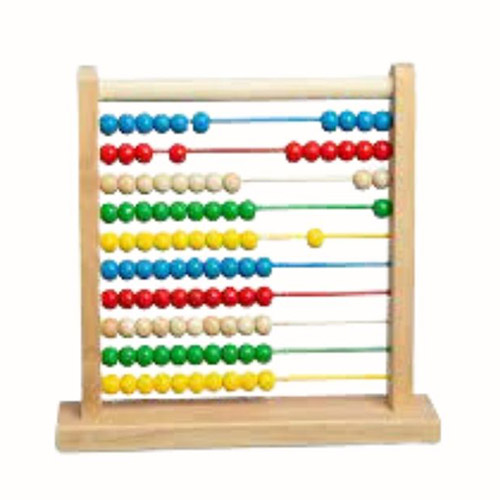
Abacus: Counting and Conceptualizing
The abacus offers a sensory experience for counting and comprehending quantities. By manipulating beads along its rods, children reinforce numerical relationships and prepare for more advanced mathematical operations.
Binominal Cubes
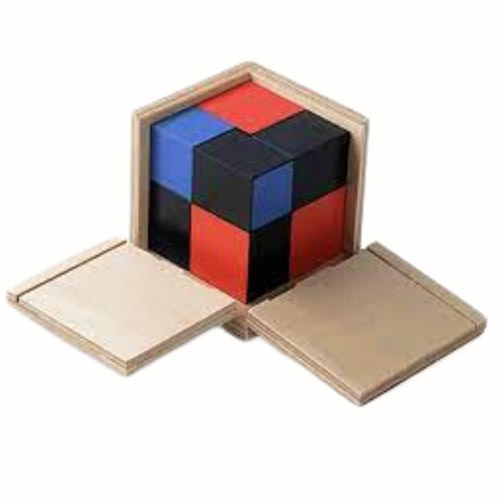
Binomial Cube: From Sensory Exploration to Mathematics
The binomial cube, comprised of cubes and prisms, serves as an indirect preparation for mathematical concepts. Beyond its sensorial aspects, it paves the way for understanding mathematical relationships, including the cube root.
Counting Stand

Counting Stand: A Playful Path to Numeracy
The counting stand, with its diverse color-coded pieces, encourages numerical exploration and pattern recognition. By stacking and arranging pieces, children embark on an engaging journey towards numerical fluency.
Conclusion
Incorporating Montessori materials into early education not only enriches learning experiences but also nurtures holistic development. These materials offer children opportunities for sensory engagement, problem-solving, and creative exploration, forming a solid foundation for lifelong learning.
Montessori materials are more than just educational tools; they are gateways to discovery, imagination, and cognitive growth. Through hands-on exploration, children forge connections between abstract concepts and tangible experiences. The diverse range of Montessori items discussed in this article empowers children to embark on a dynamic learning journey that lays the groundwork for a lifelong love of learning.

